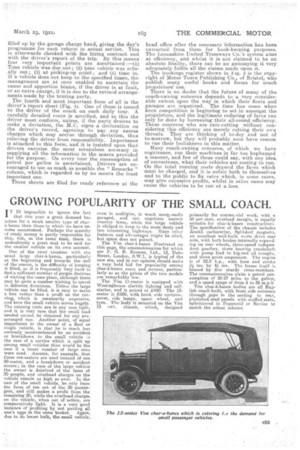GROWING POPULARITY OF THE SMALL COACH.
Page 11

If you've noticed an error in this article please click here to report it so we can fix it.
T T IS impossible to ignore the fact
that this year a great demand has arisen for a much smaller type of charit-bancs than those to which we have become accustomed. Perhaps the scarcity of ready money is partly responsible foe this, but, at the same time, there is undoubtedly a great. deal to be said for the smaller vehicle on its own account.
One of the cinet troubles with the usual large char-a-banes, particularly at the beginning and towards the end of the season, is the difficulty of keeping it filled, as it is frequently very hard to find a sufficient number of people desirous of visiting the same place, although there may be quite a number wishing to travel in different directions. Unless the large vehicle can be filled, it is easy to Make a loss rather than a profit on the running, which is necessarily expensive, and here the small vehicle scores hugely. The running costs are in any case light, and it is very rare that the small load needed cannot be obtained for any piearranged run. Another point, of equal importance to the owner of a fleet or single vehicle, is that he is much less seriously inconvenienced by an accident or break-down to the small vehicle in the case of a service which is split up among small vehicles than Would be the case if a lesser number of large ones were used. Assume, for example, that three ten-seaters are used instead of one 30-seater, and a breakdown or accident occurs ; in the ease of the large vehicle the owner is deprived of the fares of 30 people, and overhead charges on the vehicle remain as high as ever. In the case of the small vehicle, he only loses the fares of ten out of the 30 passengers, and still makes a profit from the remaining 20, while the overhead charges on the vehicle, when out &action, are comparatively light. It is a very good instance of profiting by not putting all one's eggs in the same basket. Again, due to its. lesser bulk, the small vehicle,
even in multiples, is much mom easily garaged, and can negotiate narrow country lanes, while the large vehicle is obliged to keep to the more dusty and less interesting highways. Many other features and advantages might be cited, but space does not permit. The Vim char-A.-banes illustrated on this page, the eoncessionnaires for which are F. G. R. Browne, Ltd., 13, Duk,, Street, London, SAVA, is typical of the new era, and in our opinion should make a very bold bid for popularity among char-a-bancs users and owners, particularly so as the prices of the two models tire remarkably low.
The Vim 11-seater is equipped with Westinghouse electric lighting and selfstarter, and is priced at £490. The 13seater is £560, with hood, side curtains. cover, side lamps, spare wheel, and tyre.. The body is mounted on the Vim 15 cwt. chassis, which, designed primarily for comma.riial work, with a bO•per cent, overload margin, is equally suitable for char-a-bancs constructions The specification of the chassis includes Zenith carburetter, Splitdorf magneto, an excellent well-built wurm drive rear axle, with both brakes internally expand. nig on rear wheels, three-speed independent gearbox, three bearing crankshaf. with pump feed to big-end oil troughs, and three point suspension. The engine is of 22.5 h.p., with bore and stroke 31 ins. by 4.t. ins. The frame itself is braced by five sturdy cross-members The concessiormaires claim a petrol consumption of 20-27 miles to the gallon, and a speed range of from 5 to 35 m.p.ki Vim char-a-banes bodies are all English coach-built, with front side entrance through gaps in the seating to rear, planished, steel panels. with stuffed seats, upholstered in Pega.moid or Rexine to match the colour scheme.






































